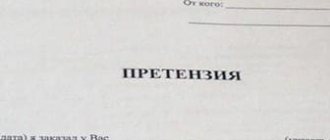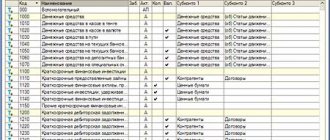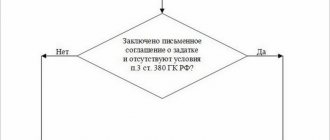Features of bills of exchange as securities
Being an unconditional debt document, a bill of exchange can be:
- Simple, i.e. drawn up between two persons and having the nature of a promissory note of the direct debtor;
- Transferable – a document, the preparation of which takes place with the participation of a third party (used to formalize the transfer of receivables).
Both a simple and a bill of exchange can be:
- Someone else's or your own;
- Discount – interest rate, i.e. providing for an interest rate at which interest will be calculated on the amount of the bill, or interest-free.
Both types of bills of exchange can be commodity, i.e., confirm the debt under a contract for the supply of goods and materials, or financial. In this case, the subject of the transaction is the bill itself. The difference in the purpose of using bills of exchange affects the accounting accounts that will be used to account for bills of exchange.
Features of the transfer of bills
In order to transfer your own bill of exchange to someone, you need
- indicate in the contents of the bill of exchange the addressee - the holder of the bill (i.e. the one to whom this bill is transferred);
- In order to document the fact of transfer, a special act should be drawn up.
If a bill of exchange is transferred in the execution of any agreement, a reference to it should be given in the act (indicating the number and date of conclusion).
In addition to the information that will directly relate to the bill of exchange, the act must necessarily contain the details of both parties (information from the registration papers of the organization or the passport data of an individual) - without them, the document will not become legally significant.
It is permissible to draw up an act not only personally, but also acting through a representative. However, in this case, it is necessary that the trusted person has in his hands a notarized power of attorney, a copy of which must be attached to the act (noting its presence in the document itself).
It should be noted that in some cases, the transfer of a bill of exchange occurs in the presence of witnesses - information about them must also be included in the act, and the document itself must be endorsed by them.
Accounting for bills of exchange: postings
Often, a promissory note in a buyer-seller relationship plays the role of a promissory note, since it arises in a situation where the buyer cannot pay for the goods with available funds, and the seller agrees to accept the bill. Such a commodity bill is not considered a security until it is transferred to a third party. To account for such bills, the buyer has an account. 60 open a subaccount 60/3 “Bills issued”, and the seller opens a subaccount 62/3 “Bills received”.
Transactions with it are recorded on both sides in the settlement accounts by postings:
| Operation | D/t | K/t |
| Accounting entries for bills issued | ||
| Reflected delivery debt | 60/1 | 60/3 |
| Security for future payment issued (behind balance) | 009 | |
| If the bill is interest-bearing, then the buyer’s debt will increase by the amount of accrued interest | 91 | 60/3 |
| Repayment of a debt | 60/3 | 51 |
| Writing off the bill after payment | 009 | |
| Accounting entries for bills received | ||
| The debt on the shipped goods is reflected | 62/ 3 | 62/1 |
| Payment security received | 008 | |
| Interest income from the bill | 62/3 | 91 |
| Received payment for goods secured by a bill of exchange | 51 | 62/3 |
| Writing off a bill after receiving payment | 008 | |
Example 1
Blitz LLC, to secure payment obligations under the supply agreement, Atrium LLC issued a promissory note in the amount of RUB 236,000. including VAT RUB 36,000. The accounting records of both organizations will reflect:
Operation D/t K/t Sum At Blitz LLC Debt to supplier for goods 41 60/1 200 000 VAT 19 60/1 36 000 A bill of exchange was issued 60/1 60/3 236 000 The bill is included in the balance sheet 009 236 000 Amortization 60/3 51 236 000 Writing off a bill 009 236 000 At Atrium LLC Revenue reflected 62/1 90/1 236 000 VAT charged 90/3 68 36 000 The cost of goods is written off 90/2 41 100 000 Bill received 62/3 62/1 236 000 The bill is included in the balance sheet 008 Payment for goods and materials received 51 62/3 236 000 Writing off a bill 008 236 000
The possibility of transferring a bill of exchange through endorsement increases the circulation period of the bill of exchange and allows it to be used as a means of repaying mutual debt obligations.
[p.166] A distinctive feature of a bill of exchange from other securities is the possibility of transferring it from hand to hand. In this case, the bill becomes a means of payment. The transfer of a bill of exchange is called an endorsement and is made by placing an endorsement on the reverse side of the bill of exchange or on an additional sheet - allonge, which is its integral part. [p.347]
The current bill of exchange legislation provides for the negotiability of bills - the possibility of transferring a bill of exchange from hand to hand as an instrument of payment using an endorsement (endorsement). Transfer of a bill of exchange by endorsement means transfer, together with the bill of exchange, to another person and the right to receive payment under this bill. The holder of the bill writes on the reverse side of the bill or on the additional sheet (allonge) the words pay to the order or pay instead of me (us), indicating who the payment goes to. [p.435]
Obligations for accounting and transfer of bills [p.235]
Obligations to partner companies for accounting and transfer of bills [p.235]
The figures indicate the unprecedented success of issuing short-term stock instruments; about 95% of all time deposits of legal entities are registered in bank securities. Their choice, breadth and activity of use by Russian banks is largely determined by the profile of a particular banking institution. Banks focused on working with small clients offer a wide selection of deposit and savings certificates. Banks that work primarily with joint stock companies use bills of exchange much more widely. Among the latter banks, there is a division into two groups: 1) banks using conservative tactics for managing bill turnover, preferring to limit the circulation of their bills by depositing for the entire period until maturity or using the inscriptions “not by order” (excluding the transfer of bills by endorsement) 2) banks carrying out aggressive strategy on the stock market, which persistently introduce their bills into circulation between enterprises. [p.147]
Let's consider the procedure for accepting bills of exchange for accounting. Bills of exchange are submitted to the bank with special registers that have a uniform form. Bills of exchange are arranged in registers by maturity. Registers are signed by the bearer or an authorized person who has the right to dispose of funds on behalf of the client. Bills submitted for accounting must have blank endorsements (endorsements) on behalf of the bearer. There is enough space left in front of the blank inscription so that the bank can put a stamp on the transfer of the bill in its name, thus converting the client’s blank inscription into a personal one. The conversion of a blank endorsement into a registered one is aimed at preventing the use of the bill of exchange in the event of its loss or theft. Since 1997, the number of transactions with banks' own bills has grown at a high rate. Thus, the turnover on discounted bills in 1997 increased on average by almost 4 times. [p.151]
Firstly, a bill is a security. And it is an independent object of civil rights, i.e. it can be sold, pledged, contributed to the authorized capital, etc. Secondly, a bill of exchange is a document certifying the property right of claim (the right to demand payment). When a bill of exchange is transferred to a third party, both the bill itself and the rights under it are transferred. In this case, the transfer of the bill is carried out on the basis of a transfer act, which is drawn up and signed by both parties to the transaction. The rights under a bill of exchange are transferred by making an endorsement on it - an endorsement, which is usually made on the reverse side of the bill. [p.65]
The enterprise-bill holder, when transferring a bill by endorsement, as well as when repaying a bill, in accordance with paragraph 4 of Art. 167 of the Tax Code of the Russian Federation, the moment of implementation comes and an obligation to pay VAT arises (with the accounting policy “on payment”). [p.87]
In accordance with the definition given in paragraph 1 of Art. 269 of the Tax Code of the Russian Federation, the bill must relate to debt obligations for the purpose of applying Chapter 25 “Organizational Profit Tax” of the Tax Code of the Russian Federation. The provisions of Art. 280 of the Tax Code of the Russian Federation, transactions of transfer of a bill of exchange by endorsement - Art. 279 Tax Code of the Russian Federation. The rules of paragraphs apply to a bill of exchange as a loan instrument. 10 p. 1 art. 250 and pp. 12 tbsp. 270 of the Tax Code of the Russian Federation, to interest and discounts on own bills - Art. 269 of the Tax Code of the Russian Federation. [p.95]
In addition, this department checks the authenticity of bills of exchange and their compliance with legal requirements. All transactions with bills of exchange are entered into the Securities Book. Reception and transmission of primary documents and bills on behalf of the accounting department is carried out by the accountant-cashier. On the basis of the act of acceptance and transfer of bills of exchange, which is an integral part of the agreement, they issue a cash receipt order when accepting a bill of exchange at the cash desk, or an expense cash order when issuing a bill of exchange with simultaneous registration of orders in the Book of receipt and expense cash orders. Incoming and outgoing cash orders indicate the basis for their preparation (for example, “presented for payment”), and the documents attached to them are listed. The PKO and RKO forms must provide details for indicating incoming and outgoing bills. All bills of exchange must be stored in fireproof metal cabinets, which at the end of the working day must be locked with a key and sealed with the seal of the accountant-cashier. [p.101]
The most common type of payment is a bill of exchange, which carries both a novation (in cases of settlement with the buyer’s own bill), and compensation (a bill of exchange of a third party), and an assignment of the right of claim (transfer of a bill of exchange by endorsement), and an exchange agreement (if payment for goods was initially provided for bill of exchange). At the same time, it contains a huge number of errors. [p.142]
Transfer of a bill by endorsement Does not coincide [p.152]
Act of acceptance and transfer of bills [p.156]
ENDORSATION - The process of transferring a bill of exchange to another person. [p.80]
The maximum increase in transactions for the transfer of bills of exchange between [p.42]
With the active use of the possibility of transferring bills of exchange, [p.44] is created
However, relations in connection with the issuance and transfer of bills of exchange constitute [p.8]
A bill of exchange can be transferred to a third party through an endorsement - an endorsement. The person who transfers the bill by endorsement is called the endorser. The person who receives the bill by endorsement is the endorser, or endorser. The act of transferring a bill of exchange is called endorsing the bill. If the drawer indicated in the bill no order or other similar expression, then the bill can be transferred only by ordinary assignment. An assignment is a concession of a claim in an obligation to another person, a transfer of one’s rights to something to someone. The one who assigns his right is called the assignor, and the one who acquires this right is called the assignee. [p.161]
The possibility of transferring a bill of exchange through endorsement increases the negotiability of the bill of exchange and adds to its function as a means of payment the function of a means of repaying mutual debt obligations. Paying off obligations with a bill reduces the need for money. [p.131]
In practice, a situation often occurs when a bill of exchange is issued through the execution of a purchase and sale agreement. However, this agreement cannot be qualified as a purchase and sale agreement, since it has a completely different legal nature. A purchase and sale agreement mediates the relationship associated with the transfer of an item belonging to one person to the ownership of another person, the buyer. In addition to money, the set of things also includes securities, bonds, bills of exchange, checks, deposit and savings certificates, etc. Consequently, a bill of exchange can be the subject of various civil transactions, including a purchase and sale agreement. At the same time, a bill acquires the properties and characteristics of a security only if it is issued by the drawer for circulation, that is, actually transferred to the first bill holder. Until this point, a document called a bill of exchange, even if it is drawn up in the prescribed form and signed by the drawer, is not a security and cannot be the subject of independent civil law transactions. This is confirmed by the fact that the application of the rules of bill law to the borrowing relations of the parties is determined precisely by the moment of the actual transfer of the bill to the first bill holder. 64 [p.64]
Bills of exchange in accounting as financial investments
If an enterprise, having free money, invests it in the purchase of bills issued by banks and capable of generating income, then we are talking about financial investments. Such bills are the object of purchase and sale, they are recorded in subaccount 58/2 “Debt securities”. Let's figure out how bills of exchange are accounted for in accounting. Postings:
| Operation | D/t | K/t |
| Purchase of a bill of exchange | 76 (60) | 51 |
| Acceptance for registration | 58/2 | 76 (60) |
| The difference between the purchase price and the face value is reflected | 58/2 | 91/1 |
Example 2
On January 25, 2018, the company acquired a bank bill with a face value of RUB 2,000,000, issued on January 25, 2018, with a payment due date at sight, but not earlier than May 5, 2018. Interest accrual is 8% per annum. On 04/05/2018, the company executed a compensation agreement with the condition of transferring the bill of exchange to the counterparty who performed the work worth RUB 2,000,000. without VAT. It was accepted as payment for the work. The transaction was formalized by an agreement for the transfer of a promissory note.
Accounting entries:
Operation D/t K/t Sum 25.01.2018 Bill paid 76 51 2 000 000 The bill is included in financial investments 58/2 76 2 000 000 31.01.2018 Accrual of interest on the bill for January 2,000,000 x 8% / 365 x 6 days. 76 91/1 2630 28.02.2018 Interest accrued for February (2,000,000 x 8% / 365 x 28) 76 91/1 12 274 31.03.2018 Interest accrued for March (2,000,000 x 8% / 365 x 31) 76 91/1 13 589 05.04.2018 The work performed was accepted for accounting 20 60 2 000 000 Interest accrued for April (2,000,000 x 8% / 365 x 5) 76 91/1 2192 The contractor was given a bill of exchange to repay the mortgage 60 91/1 2 000 000 The nominal value of the bill has been written off 91/2 58/2 2 000 000
Stock market instruments
The stock market largely determines the development trends of the country's economy, and also experiences changes in its market conditions. It performs a number of functions that ensure the stability of the economic system. Among them are:
- accumulation of funds and capital investments;
- redistribution of monetary resources between sectors of the real sector of the economy;
- ensuring a minimum threshold budget value in order to avoid budget deficits;
- receiving additional income;
- attracting the population to investment activities;
- providing open, accessible information about changes in the market;
- pricing of stock instruments;
- distribution of risks between participants in transactions;
- influence on changes in forms of ownership.
Note 1
The instrument of interaction between subjects on the stock market is a security. It is a document of strict reporting and execution. Paper itself has no value. Value is determined by the share of its owner's property right to a piece of property or capital.
Are you an expert in this subject area? We invite you to become the author of the Directory Working Conditions
The development of high technologies has contributed to the transition from documentary forms of stock instruments to uncertificated ones. This simplified the procedures for conducting transactions and transferring rights. In this case, rights to packages of securities are subject to registration in registers. The owner can always receive a statement of his securities.
The types of stock instruments used in a country are determined by its legislation. So in Russia fifteen forms are prescribed, which include private and public debt obligations, shares, certificates of deposit and savings, bills, mortgages, warehouse receipts of various types, and others.
The issue of stock instruments is often carried out to attract additional funds. Entrepreneurs themselves can invest free assets in securities in order to generate additional income. As a rule, investment portfolios that include various types of securities are used for such activities. Using a portfolio allows you to increase the efficiency of using each document separately, while reducing risks across the entire package of investment documents.
Finished works on a similar topic
Coursework Third party promissory note 400 ₽ Abstract Third party promissory note 240 ₽ Test paper Third party promissory note 200 ₽
Receive completed work or specialist advice on your educational project Find out the cost
simplified tax system
The transfer of a third party's bill of exchange in payment for goods (work, services) leads to the emergence of two transactions for tax purposes (for the acquisition of goods (work, services) and for the sale of a security).
If an organization pays a single tax on income, on the date of transfer of the bill of exchange to the counterparty, the tax base must be increased by the cost of goods received (work performed, services rendered) for which the organization pays with this third party bill of exchange. That is, to recognize income from the sale of the bill (clause 1 of article 346.15, clause 1 of article 249, clause 1 of article 346.17 of the Tax Code of the Russian Federation, letter of the Ministry of Finance of Russia dated October 10, 2006 No. 03-11-04/2/202 ).
Do the same when calculating the single tax on the difference between income and expenses (clause 1 of Article 346.15 of the Tax Code of the Russian Federation, letter of the Ministry of Finance of Russia dated October 10, 2006 No. 03-11-04/2/202). However, the tax base can be reduced by the amount of expenses. Reduce the income received by the cost of purchasing the bill (clause 2 of Article 280, subclause 23 of clause 1 of Article 346.16 of the Tax Code of the Russian Federation, letter of the Ministry of Finance of Russia dated January 24, 2011 No. 03-11-06/2/08).
Expenses for which the organization paid with a third party’s bill of exchange shall be considered paid on the date of its transfer. Accept them for accounting at the transaction price, but not more than the amount of the debt obligation specified in the bill. This procedure is established by subparagraph 5 of paragraph 2 of Article 346.17 of the Tax Code of the Russian Federation. At the same time, to calculate the single tax, take into account the peculiarities of accounting for certain types of expenses when simplifying. For example, expenses for the purchase of goods for which a bill of exchange was transferred can be taken into account only after sale (subclause 23, clause 1 and clause 2, article 346.16, subclause 2, clause 2, article 346.17 of the Tax Code of the Russian Federation).
Design nuances
Considering that the format of the acceptance certificate is not regulated, the subtleties of its preparation are more of a recommendatory nature. Thus, the parties can type it using word processors on a computer or write it by hand.
The main condition is that the text must be compiled in two copies (one for each side). If there is a need, the law does not prohibit making copies. Only in order for them to have legal force, notarization is necessary.
What to do with debt to two parties
You need to know that, like any other security, a bill of exchange must contain a number of mandatory details, the absence of which makes it invalid. These conditions are described in detail in the Decree of the Central Executive Committee of the USSR and the Council of People's Commissars of the USSR No. 104/1341:
- the text must contain the name “bill”;
- a simple promise to pay, unsecured;
- name of the payer;
- deadline for payment;
- name of the place where the payment was made (if absent, the place where the paper was made is considered such a place);
- the name of the person being paid;
- date and place where the document was drawn up;
- signature of the person who issued the document;
In a promissory note, unlike a bill of exchange, there is no need to indicate the payer.
Accounting for bills of exchange and accounting entries are determined by:
- terms of the transaction;
- classification of bills.
What actions does the creditor take?
The beneficiary's obligation to pay is reflected in account 62 “Settlements with buyers and customers.” To do this, the receivable must be transferred by operation from one subaccount to another:
- Dt 62.03 “Bills received” Kt 62.01 “Settlements with buyers and customers.”
This receipt cannot serve as a financial investment, which is justified by clause 3 of PBU 19/02. If the conditions provide for an income interest, the accounting department must reflect it when repaying the debt:
- Dt 51 “Settlement accounts” Kt 62.03 – the drawer paid off the obligations;
- Dt 51 Kt 91.01 “Other income” - the amount received as interest is taken into account.
Another option is possible when interest is included in the debt and accrued monthly in the program:
- Dt 62.03 Kt 91 “Other income and expenses.”
Note from the author! Whatever method of working with bills the company chooses, it must necessarily consolidate it in its Accounting Policy.
For example, Novy Mir LLC issued a promissory note to Delets LLC as a promise to pay for the rental of non-residential premises previously leased. The amount of rent receivable amounted to 714,000 rubles. The conditions stipulate a return percentage of 1.5% of the amount of obligations. It is necessary to calculate the interest when repaying the debt:
- 714,000 * 1.5% = 10,710.00 rubles.
So, Delets LLC performs a number of accounting operations:
- Dt 62.03 subconto LLC "New World" Kt 62.01 subconto LLC "New World" - debt in the amount of 714,000 rubles was transferred;
- Dt 62.03 Kt 91.01 – interest accrued 10,710.00 rubles;
- Dt 51 Kt 62.03 – money for obligations of 714,000 rubles was received in the current account;
- Dt 51 Kt 62.03 – interest debt in the amount of 10,710.00 rubles was repaid.
Table 1. Balance sheet for account 62
| Check | Balance at the beginning of the period | Period transactions | balance at the end of period | |||
| Counterparties | Debit | Credit | Debit | Credit | Debit | Credit |
| 62 | 714 000,00 | 724 710,00 | 1 438 710,00 | |||
| 62.01 | 714 000,00 | 714 000,00 | ||||
| LLC "New World" | 714 000,00 | 714 000,00 | ||||
| 62.03 | 724 710,00 | 724 710,00 | ||||
| LLC "New World" | 724 710,00 | 724 710,00 | ||||
| Total | 714 000,00 | 724 710,00 | 1 438 710,00 | |||
What should a debtor do?
If we consider accounting with the drawer, then account 60 “Settlements with suppliers and contractors” is most often responsible for the goods (services) taken:
- Dt 60.03 “Bills issued” Kt 60.1 “Settlements with suppliers and contractors” - in the amount of a bill issued to the supplier as a promise to pay;
- Dt 60.03 Kt 51 – the debt is transferred to the creditor.








